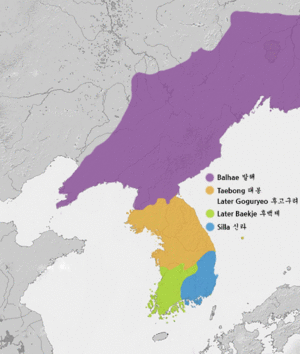Later Three Kingdoms facts for kids
| Later Three Kingdoms | |
 |
|
Quick facts for kids Korean name |
|
|---|---|
| Hangul |
후삼국시대
|
| Hanja |
後三國時代
|
| Revised Romanization | Husamguk Sidae |
| McCune–Reischauer | Husamguk Sidae |
The Later Three Kingdoms period (Korean: 후삼국시대; 889–936 AD) was a time in ancient Korea when some old kingdoms reappeared. These kingdoms had ruled the Korean peninsula for a long time, from around 1 BC to the 7th century.
After the Unified Silla kingdom ruled Korea by itself for about 200 years, it started to get weaker. This created a chance for new states to rise up. These new states even took on the names of the older kingdoms. It was a confusing time with many alliances and fights. But eventually, one state, called Goryeo, became the strongest. Goryeo was named after the ancient northern Goguryeo kingdom. It brought Korea back together and started a new dynasty that lasted for nearly 500 years.
Contents
A Time of Change in Korea
The Unified Silla Kingdom (668–935) had been in charge of the Korean peninsula for three centuries. But by the 10th century, its power was fading. During this time, local leaders, called aristocrats, became more independent. They started acting like powerful warlords in their own areas. Farmers and common people often faced hardship.
New Leaders Emerge
Two important leaders appeared during this period: Kyŏn Hwŏn and Kung Ye. They both wanted to create new kingdoms.
Kyŏn Hwŏn's Kingdom
Kyŏn Hwŏn (867–936) was a strong leader who had been an officer in the Silla army. He saw the problems in the government and took control of the city of Muju in 892. In 900, Kyŏn teamed up with a bandit leader named Yang Kil. Together, they started a new kingdom in the southwest part of Korea. They called it Later Baekje, bringing back the name of the old Baekje kingdom. Kyŏn Hwŏn chose Jeonju as his capital city.
Kung Ye's Kingdom
In 901, another leader named Kung Ye declared a new Goguryeo state in the north. Kung Ye was an aristocratic Buddhist monk. He had been one of Yang Kil's commanders. But he later turned against Yang and defeated him in 901. Kung Ye's first capital was at Songak (Gaesong). Later, he moved it to Cheorwon. He also changed the name of his kingdom twice, first to Majin in 904, and then to Taebong in 911. However, his kingdom is most remembered as Later Goguryeo (후고구려).
Kung Ye was known for being a bit strange and strict. People, both farmers and nobles, thought he was a tyrant. He reportedly believed he was the Maitreya Buddha, a future Buddha. He even claimed to have mind-reading powers. Stories say he had 200 monks follow him, chanting prayers. In 918, his generals decided they had enough. They launched a coup and removed him from power.
Wang Geon Unites Korea
After Kung Ye was removed, his general Wang Kŏn (also known as Wang Geon) took over. Wang Geon brought back the name Goryeo for the kingdom. This started a long struggle for control of the peninsula.
Battles and Alliances
Later Baekje attacked the Silla kingdom in 920 and 924. Silla asked Later Goguryeo for help. In 927, Baekje attacked and took over the Silla capital, Gyeongju. The Silla king, Gyeongae of Silla (ruled 924–927), was forced to end his own life. A new king, Kim Pu, was put in place by Baekje. Wang Geon fought back by attacking the Later Baekje capital. Kyŏn Hwŏn then lost a battle to Wang Geon's forces.
Back in the Baekje capital, Kyŏn Hwŏn faced a rebellion from his own son, Kyŏn Sin-gŏm. His son was upset because Kyŏn Hwŏn wanted his younger brother to be the next king. So, Kyŏn Sin-gŏm imprisoned his father.
The End of the Later Three Kingdoms
Wang Geon now controlled most of Silla's land. His power as the real ruler of Korea was recognized by the Tang dynasty of China in 932. In 934, Wang Geon won a big victory over Baekje at Unju (Hongseong). After this, many people who had fled from the northern state of Balhae (Parhae) felt it was safe enough to return to Korea.
In 935, Gyeongsun of Silla surrendered and named Wang Geon as his successor. In the same year, Kyŏn Hwŏn, who had escaped to Wang Geon's territory, asked his old enemy for help. He wanted Wang Geon to remove his son, Kyŏn Sin-gŏm. Kyŏn Hwŏn led a Goryeo army to Baekje. The fighting and the deaths of both Kyŏn Sin-gŏm and Kyŏn Hwŏn in 936 greatly weakened Baekje.
This allowed Wang Geon to finally unite the country again under the name of Goryeo. This is where the name "Korea" comes from today. Wang Geon was later given the title of Taejo of Goryeo, meaning 'Great Founder.' He started a dynasty that would rule Korea for the next five centuries.
See also
- List of monarchs of Korea
- Taejo of Goryeo
- Taejo Wang Geon (TV series)
- Tomb of King Wanggon
- Family tree of the Goryeo kings
- Silla monarchs family tree

